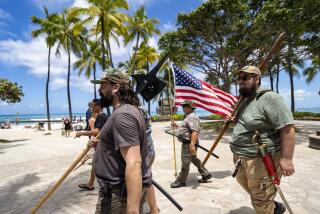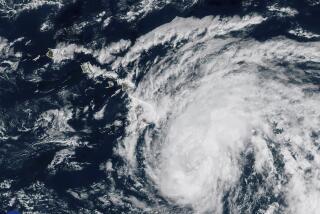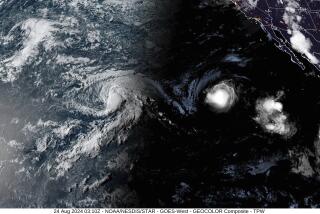Hurricane Deals Direct Blow to Kauai : Storm: Iniki’s 160-m.p.h. gusts pound island, knocking out power and phone service. The hurricane is the most powerful to hit the Hawaiian Islands in this century.
LIHUE, Hawaii — Hurricane Iniki dealt a direct blow to the Hawaiian island of Kauai on Friday with winds gusting to 160 m.p.h. and torrential rain. Twenty-foot waves crashed over coastal highways and the island lost all power and telephone service even before the worst of the storm hit.
It was the most powerful hurricane in the Hawaiian Islands this century, said Bob Sheets, director of the National Hurricane Center in Coral Gables, Fla. He said Iniki was about the same strength as devastating Hurricane Andrew, which roared through the Bahamas, south Florida and Louisiana last month.
Torrential rain fell on Kauai and Niihau, an island 25 miles to the west that is populated by about 300 native Hawaiians. The weather service also said there were reports of damage to buildings on Kauai, but gave no details, and other damage reports couldn’t be obtained immediately.
Hurricane Iniki’s fiercest winds covered all of Kauai, weather service forecaster Saul Price said. The island is roughly circular and 30 miles across, and has a population of more than 50,000.
The eye of the fast-moving storm passed over Kauai starting at about 4 p.m. (7 p.m. PDT), said Andy Chun, lead forecaster at the National Weather Service in Honolulu. An hour later the eye was reported to be about 50 miles north of Kauai, back over the North Pacific.
Oahu, the state’s most populated island, was spared the brunt of the storm, though a heavy surf pounded the coast and power lines were blown down. Kauai is separated from Oahu by an 80-mile-wide channel.
Iniki had sustained wind to 130 m.p.h. and gusts to 160 m.p.h. as it passed over Kauai, the weather service said. That was down from 145 m.p.h., with 175 m.p.h. gusts, earlier Friday.
Chun said the eye of Iniki passed over the western part of Kauai, where there are many sugar cane plantations. Most of the island’s resorts and other development are concentrated on the easternmost part of Kauai, where Lihue, the largest city, is located.
Before the worst of the hurricane struck, streets of Lihue were virtually deserted as intensifying winds bent palm trees sideways and rocked parked cars. Heavy rains drenched the area.
Twenty-foot surf along Kauai’s southern coast sent waves over roads and highways, the weather service said. It said the island lost all electricity at 1:20 p.m. All phone links to the island were lost by 3 p.m., Hawaiian Telephone Co. said.
On Oahu, 44,000 of the 250,000 customers were without electrical service at 3 p.m., said Hawaiian Electric Co. spokesman Chuck Freedman.
Earlier, as the hurricane approached the Hawaiian Islands, schools and businesses closed. People jammed stores to stock up on food, batteries, candles and masking tape. Hotel guests filled bathtubs with emergency water. Residents in low-lying areas evacuated their homes. Navy ships steamed out of Pearl Harbor to ride out the storm at sea, and Navy planes fled Barbers Point Naval Air Station on Oahu to Moffet Field in California.
As Iniki, which means “sharp and piercing, as wind or pangs of love” in Hawaiian, bore down on the islands, Honolulu Mayor Frank Fasi faxed a letter to President Bush warning of impending disaster and asking him to be ready to extend federal aid.
Hawaii got its first warning that Iniki was coming at 5:30 a.m. Civil defense sirens wailed in Honolulu, home of Waikiki Beach. Residents and tourists awakened to radio announcers warning everyone to stay home and prepare. As people lined up at stores and gasoline stations, the Red Cross opened scores of shelters on both Oahu and Kauai, and volunteers began arriving from California.
By midday, the warnings were taking effect. Residents and guests at hotels within 300 feet of the beach on Oahu responded to orders to move inland. Mayor Fasi said they numbered about 20,000. Hotel workers tried frantically to secure furniture around swimming pools. They handed out candles. Many tourists flocked to airports to stand by for flights. Despite the evacuation orders, Fasi said he did not expect hotels to move all of their guests out. “We’re not evacuating everyone,” he said. “There are just too many guests. The hotel managers got together. What they’re doing for the safety of their guests is enough. These are concrete buildings, after all.”
But Fasi was tougher about residents in single-family homes, particularly those in the area near Waikiki Beach.
“Get out!” he ordered them. “You had better not be within 100 yards of the shore.”
On Kauai, Mayor JoAnn Yukimura similarly urged coastal residents and visitors to evacuate inland. She feared that the surf would devastate low-lying parts of the island. Flights between Kauai and Oahu were canceled, along with other inter-island flights, at midmorning.
By midafternoon, most fights from the mainland also had been canceled. Some were diverted to the island of Hawaii.
Guests at the massive Sheraton-Waikiki Hotel in Honolulu were herded into a second-floor ballroom to wait out the storm. Hotel officials said they would be safe there from breaking glass and flying debris. Before leaving their rooms, the guests pulled porch furniture inside.
“We want to get them (the guests) down to the ballroom and get them food and get them comfortable,” said B.J. Hughes, the hotel spokeswoman. “They have a lot of questions, but they’re relatively calm.”
Police with bullhorns cleared all of the beaches outside the hotel, scooping up tourists and directing them to the Sheraton and to other high-rise hotels--or to emergency shelters. “We just came from Miami to get away, and I guess we’re caught in the middle of another one,” sighed Larry Blitz, a Florida resident, shaking his head as he left the waterfront.
As city buses began shuttling residents in the Waikiki area toward the Oahu hills, Outrigger Hotels Hawaii moved guests out of some of its oceanfront rooms and the lower floors at two of its hotels. The Moana Hotel, a historic wooden landmark recently restored to turn-of-the-century elegance, began shifting some guests to neighboring Sheraton properties and away from danger.
Some hotel owners piled sandbags around their buildings to protect them. Others ordered workers to crisscross windows with masking tape, partially blocking views of the roiling ocean nearby and of Diamond Head in the distance. “This is the point of no return,” said Thomas Schroeder, a meteorologist at the University of Hawaii. “Other than TV anchors, everybody should be heading for high ground.”
At a downtown Safeway store in Honolulu, lines of people snaked through the aisles. Customers waited for as long as an hour to ring up their purchases.
In Honolulu, the state capital, Gov. John Waihee spoke highly of emergency planning. “(It) seems to be falling into place at the county level,” he told a Honolulu radio station. “I talked to Washington a couple of times and once to the director of FEMA (the Federal Emergency Management Agency). The army called to offer any backup resources they may have to help us.
“I think that right across the state, they have been preparing for this type of emergency. People have responded tremendously. They are listening to the sirens. They are responding appropriately . . . . They are calling in with questions. Communications seems to be working very well.
“I think this is a time for us to remember our neighbors,” the governor added. “If we look out for each other and get questions answered and pull together, we should be all right.”
More to Read
Sign up for Essential California
The most important California stories and recommendations in your inbox every morning.
You may occasionally receive promotional content from the Los Angeles Times.










